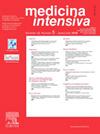在COVID-19大流行期间ECMO治疗急性呼吸窘迫综合征的经验
IF 3.1
4区 医学
Q2 CRITICAL CARE MEDICINE
引用次数: 0
摘要
目的分析2019冠状病毒病疫情期间体外膜氧合(ECMO)治疗急性呼吸窘迫综合征(ARDS)的经验。设计回顾性、观察性、单中心研究。西班牙三级医院。2020年3月至2023年3月期间,我们中心接受ECMO系统治疗的成年COVID-19 ARDS患者。干预措施:回顾性收集住院和随访期间的变量。收集人口学变量、临床病史、ECMO治疗相关变量、COVID-19波数、住院死亡率、不良事件、ICU和住院时间、随访时功能状态。结果共纳入81例患者。其中,61例(75%)患者在住院期间死亡。死亡的患者年龄较大,有更多的合并症。在第二次、第三次和第六次浪潮中,死亡率更高。在多变量分析中,死亡率的唯一独立预测因子是年龄(OR 1.24, 95% CI (1.027-1.5, P = 0.025)。出院后,40%的患者由于呼吸衰竭需要氧气和关节病变而难以恢复正常生活。结论流感大流行期间住院死亡率上升。年龄较大是死亡率的唯一独立预测因子。出院后,在前18个月的随访中没有死亡记录,尽管40%的存活患者有呼吸和运动后遗症,使他们难以恢复正常生活。本文章由计算机程序翻译,如有差异,请以英文原文为准。
Experience with ECMO therapy for acute respiratory distress syndrome treatment throughout the COVID-19 pandemic
Objective
To analyze our experience with extracorporeal membrane oxygenation (ECMO) therapy for acute respiratory distress syndrome (ARDS) treatment during the COVID-19 pandemic.
Design
Retrospective, observational, single center study.
Setting
Third-level hospital in Spain.
Patients
Adult patients with COVID-19 ARDS treated with an ECMO system in our center between March 2020 and March 2023.
Interventions
Retrospective collection of variables during hospital admission and follow-up.
Main Variables of Interest
Demographic variables, clinical history, variables related to ECMO therapy, COVID-19 wave number, in-hospital mortality, adverse events, ICU and hospital length of stay, and functional status at follow-up were collected.
Results
Eighty-one patients were included. Of these, 61 patients (75%) died during hospitalization. Patients who died were older and had more comorbidities. During the second, third, and sixth waves, mortality was higher. In the multivariate analysis, the only independent predictor of mortality was age (OR 1.24 95% CI (1.027–1.5, P = 0.025). After discharge, 40% of patients had difficulties returning to normal life due to respiratory failure requiring oxygen and arthropathies.
Conclusion
In-hospital mortality increased during the pandemic. Older age was the only independent predictor of mortality. After discharge, no deaths were recorded during the first 18 months of follow-up, although 40% of surviving patients had respiratory and motor sequelae making it difficult for them to return to a normal life.
求助全文
通过发布文献求助,成功后即可免费获取论文全文。
去求助
来源期刊

Medicina Intensiva
CRITICAL CARE MEDICINE-
CiteScore
2.70
自引率
20.00%
发文量
146
审稿时长
33 days
期刊介绍:
Medicina Intensiva is the journal of the Spanish Society of Intensive Care Medicine and Coronary Units (SEMICYUC) and of Pan American and Iberian Federation of Societies of Intensive and Critical Care Medicine. Medicina Intensiva has become the reference publication in Spanish in its field. The journal mainly publishes Original Articles, Reviews, Clinical Notes, Consensus Documents, Images, and other information relevant to the specialty. All works go through a rigorous selection process. The journal accepts submissions of articles in English and in Spanish languages. The journal follows the publication requirements of the International Committee of Medical Journal Editors (ICMJE) and the Committee on Publication Ethics (COPE).
 求助内容:
求助内容: 应助结果提醒方式:
应助结果提醒方式:


